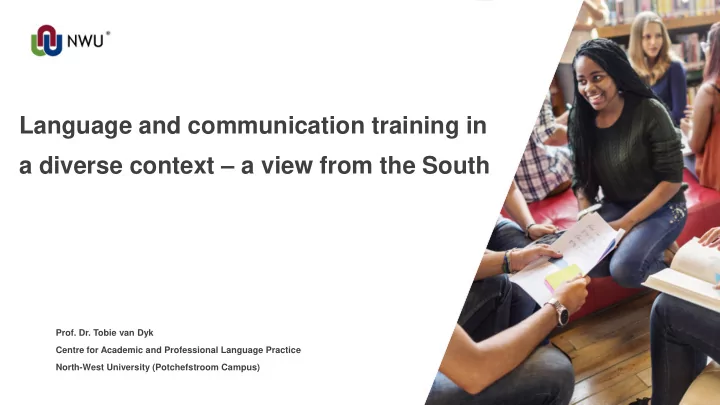

Language and communication training in a diverse context – a view from the South Prof. Dr. Tobie van Dyk Centre for Academic and Professional Language Practice North-West University (Potchefstroom Campus)
South Africa – a country of extremes • Population • 51 000 000 (56 000 000) • Cultural/ethnic groups • Five groups (Black African = 80.2%; White = 8.4%; Coloured 8.8%; Indian/Asian 2.5%; Unspecified 0.5%) • Languages • 11 Official languages; sign language has special status • [1] IsiZulu 22.7%; [2] IsiXhosa 16%; [3] Afrikaans 13.5%; [4] Sepedi 9.6%; [5] English 9.1% • English considered to be the lingua franca questionable (approx. 50% have basic proficiency); still the main language of commerce and science • Rich and poor • Developed and developing • Rich in its diversity, but a nation where there is Unity in Diversity
Health care • Private (excellent; among the best in the world) • Public (good, with pockets of world class excellence, but also big challenges) • Academic hospitals, regional hospitals, local hospitals, clinics • Health care training, nurses in particular • Highly regulated by Government • Professionals councils • Compulsory community service year (in some cases two years) for ALL health professionals • Life expectancy (61 70 = 4% 80 = 0.6% 85 = 0.5%)
Health care and communication • Highly problematic, particularly in rural areas • Basic communication is crucial, particularly in life-death-situations (languages, cultures, life expectancy) • Possible solutions • Training interpreters: expensive, albeit high success rates – “... there is a clear gap in the literature on the careful description and appraisal of innovative and low- cost ways of attempting to address these issues...” • Language and communication training: cheaper, soft skills to be included in curricula – MoM and NoM good examples
Not only language and communication training... • Acculturation is imperative • Culture is neither monolithic, nor is it always explicit • Definitions • “... the process by which a human being acquires the culture of a particular society...” • “... the process of cultural change and psychological change that results following meeting between cultures...” • “... using the community’s currency – norms, values and expectations – with comfort and confidence...” • Decolonising the curriculum • “... and your arguments are based upon Western standards of logic and rationality which are purely subjective and therefore we don’t pay any attention to them...” • A postmodern view • “... a rejection of traditional canons of logic and rationality and truth ... simply share our narratives and invite people to participate in it ...”
NoM, MoM and the rest • Empirical evidence of value • Achievement in terms of language and communication • Perceptions • Culturally sensitive
In spite of … • all the research • all the progress made in practice • all the commitment to quality teaching and learning … it is important to continue reflecting on whether we are acting in the best interest of both patients and health care professionals. Are we balancing the scale or are we tipping it? Therefore, … • more borders have to be crossed • more comfort zones have to be challenged • but … more growth will potentially be achieved, and NoM provides us the platform to achieve this.
Recommend
More recommend